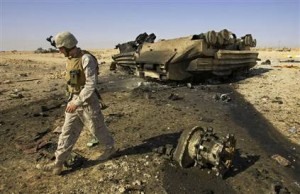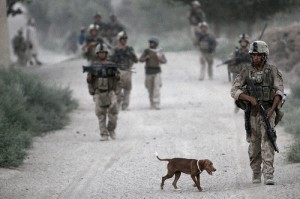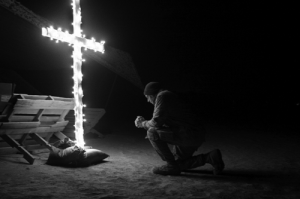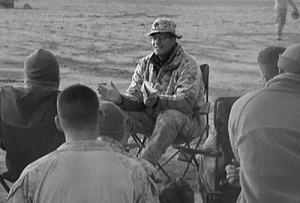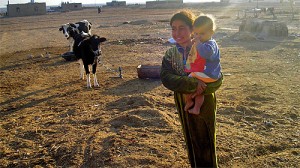While supporting Israel’s right to a robust self defense, The Captain’s Journal has also questioned both the strategic and operational goals of the current Israeli offensive, especially since it is being run by the more leftist administration currently in power in Israel. But there are deeper questions still about the operation, ones that drive to the heart of the matter.
Robert Kaplan discusses the larger war in which Israel is engaged.
Israel has just embarked on a land invasion of the Gaza Strip after a week of aerial bombing. Gaza is bordered by Egypt, and was under Egyptian military control from 1949 through 1967. And yet in a startling rebuke to geography and recent history—and in testimony to the sheer power of audacity and of ideas—the mullahs in Teheran hold more sway in Gaza today than does the tired, Brezhnevite regime of Hosni Mubarak in Egypt. Gaza constitutes the western edge of Iran’s veritable new empire, cartographically akin to the ancient Persian one, that now stretches all the way to western Afghanistan, where Kabul holds no sway and which is under Iranian economic domination.
Israel’s attack on Gaza is, in effect, an attack on Iran’s empire, the first since its offensive on Iranian-backed Hezbollah in 2006. That attack failed for a number of reasons, not least of which was Israel’s poor intelligence on Hezbollah: historically, its intelligence on the Palestinians has been much better. Moreover, this attack seems more deliberately planned, with narrower, publicly stated aims – all in all, a more professional job. But there is a fundamental problem with what Israel is doing that goes to the heart of the postmodern beast that the Iranian empire represents.
To start with, Hamas does not have to win this war. It can lose and still win. As long as no other political group can replace it in power, even as some of its diehards can continue to lob missiles, however ineffectually, into Israel, it achieves a moral victory of sorts. Moreover, if Mahmoud Abbas’s Fatah movement tries to replace Hamas in power, Fatah will forever be tagged with the label of Israeli stooge, and in the eyes of Palestinians will have little moral legitimacy. Israel’s dilemma is that it is not fighting a state but an ideology, the postmodern glue that holds together Greater Iran.
This is similar to the view espoused by Dr. Ely Karmon, namely that “The present conflict in Gaza must therefore be understood in its broad regional context. Israel is fighting not only Hamas, a radical Islamist religious/political movement whose ideological and strategic goal is to destroy the Jewish state in order to build on it a Taliban-style one, but is facing a coalition of radical actors — Iran, Syria, Hizballah and Hamas — which is responsible for the destabilization of the entire Middle East for the last two decades … Hamas is a crucial element for Iran because it is the only Sunni member of the coalition, a faction of the broader Muslim Brotherhood movement (the Sunni Syria is actually led by an Alawi/Shia dictatorship), and represents the Palestinian cause, so dear to the Arabs and Muslims worldwide.”
In The Globalization of Jihad in Palestine, The Captain’s Journal pointed out that Ayman al-Zawahiri and the al Qaeda leadership had heretofore rejected participation in jihad with Hamas because of its acceptance of nationalism and democracy, two things al Qaeda hates most. Global jihad (and hence, al Qaeda) doesn’t recognize borders or the legitimacy of states. But we also pointed out that radical Salafist schools were developing across Palestine – including Gaza – financed by Saudi money and producing young radicals accepting of a more global and even less tolerant perspective.
Adding to this narrative is an analysis by The Washington Institute for Near East Policy.
Both Hamas and the Gazan jihadist groups share a desire to destroy Israel and impose sharia, but Hamas focuses on local interests limited to the Palestinian arena. Hamas, therefore, directs its energy largely at Israel, while these groups target foreigners as well. The Salafi-jihadist groups espouse an ideology of “pure resistance,” within which there is no room for ceasefires or temporary halts in attacks against the enemy. Some of their members were therefore especially motivated to continue attacks following Hamas’s agreement to a tahdiyah, or lull …
Although these groups do not aim to usurp Hamas’s control of Gaza, the expansion of their power and popularity poses an ideological and practical challenge for Hamas and emphasizes the dichotomy in the movement; on one hand, Hamas is a resistance movement siding with an ongoing jihadist struggle, on the other, it is a sovereign power that is required to compromise on daily governance issues. Hamas is worried that this phenomenon will gain popularity among the young generation, since it represents “pure resistance.” Confronting this phenomenon not only endangers Hamas’s image on the street, but also forces the organization to confront one of the cornerstones of its identity: the ideological adherence to jihad as a way to achieve its goals. This very dilemma may go a long way toward explaining why Hamas allowed the tahdiyah to erode; attacks from time to time allow Hamas to explain that it remains committed to resistance.
In the wake of the current crisis, Hamas may choose to ease its crackdown on these jihadist groups, causing repercussions beyond Gaza. Strengthened Salafi-jihadist groups in Gaza could ultimately pose a threat not only to Hamas, but also, as the various attacks and foiled plots over the past several years illustrate, to Israeli and Western interests as well.
Al Qaeda’s inability to utilize differing sects in its global struggle, e.g., the nationalistic Hamas, is not a mistake made by the Persian empire which, while Shi’a, has no problems working with the Sunni Hamas. Al Qaeda may look on with envy at the empire carefully constructed by Iran, but in the main Israel is surrounded by Iranian proxies. True, there are allegations and counter-allegations over the role of al Qaeda in Lebanon (page 5).
There is no official consensus in Lebanon on whether al-Qa`ida has a presence in the country. Since the assassination of former Prime Minister Rafiq Hariri in February 2005, all politics in Lebanon has been polarized. It is on the threat of terrorism where the gap is arguably most pronounced. On the one hand, the anti-Syrian political coalition, led by Prime Minister Fuad Siniora and parliament majority leader Saad Hariri, believes that al-Qa`ida does not have an indigenous presence in Lebanon. What the country faces instead is a fabricated threat by Damascus and its intelligence services that is intended to destabilize Lebanon and restore Syrian hegemony. On the other hand, the pro-Syrian alliance, spearheaded by Hizb Allah (also spelled Hezbollah) and the Free Patriotic Party of Michel Aoun, judges that al-Qa`ida exists in Lebanon and poses a real threat to national security. For them, the rise of al-Qa`ida in the country is largely attributed to a devilish pact between Lebanese Sunni politicians and extremist Islamic factions in the north, the purpose of which is to counter-balance the perceived ascending power of Shi`a Hizb Allah. The Lebanese Internal Security Forces (ISF), an institution that is perceived to be fairly loyal to Siniora—in addition to Egypt and Saudi Arabia, the two most influential regional patrons of the anti-Syrian coalition—are also accused by the pro-Syrian alliance of having a hand in financing and arming these terrorist groups.
But the argument itself is evidence of the paltry presence of al Qaeda, or strongly Sunni anti-Persian elements. Syria is an apparatchik of Iran, and Damascus gets its orders directly from Tehran, orders it immediately relays to Hassan Nasrallah who governs Hezbollah, which is itself Iran’s troops deployed in Lebanon. Hamas, like Hezbollah but still following in its footsteps, serves the interests of Iran.
Michael Ledeen makes a strong case that Iran has turned Hamas loose to lose if necessary, a sort of cowardly betrayal of the Hamas leadership. Further, argues Ledeen, there is rot inside of Iran. Indeed, there is a budding insurgency in Western Iran, one that we have argued that should be aided in fomenting a full blown insurgency and regime change inside of Iran.
Caroline Glick makes a similar argument to Ledeen, but ends with a stern warning.
ALAS, THERE is another possible explanation for Iran’s apparent decision to abandon a vassal it incited to open a war. On Sunday, Iranian analyst Amir Taheri reported the conclusions of a bipartisan French parliamentary report on the status of Iran’s nuclear program in Asharq Alawsat. The report which was submitted to French President Nicolas Sarkozy late last month concluded that unless something changes, Iran will have passed the nuclear threshold by the end of 2009 and will become a nuclear power no later than 2011. The report is notable because it is based entirely on open-sourced material whose accuracy has been acknowledged by the Iranian regime.
The report asserts that this year will be the world’s final opportunity to prevent Iran from acquiring nuclear weapons. And, as Taheri hints strongly, the only way of doing that effectively is by attacking Iran’s nuclear installations.
In light of this new report, which contradicts earlier US intelligence assessments that claimed it would be years before Iran is able to build nuclear weapons, it is possible that Iran ordered the current war in Gaza for the same reason it launched its war in 2006: to divert international attention away from its nuclear program.
It is possible that Iran prefers to run down US President George W. Bush’s last two weeks in office with the White House and the rest of the world focused on Gaza, than risk the chance that during these two weeks, the White House (or Israel) might read the French parliament’s report and decide to do something about it.
So too, its apparent decision not to have Hizbullah join in this round of fighting might have more to do with Iran’s desire to preserve its Lebanese delivery systems for any nuclear devices than its desire to save pennies in a tight economy.
And if this is the case, then even if Israel beats Hamas (and I eat my hat), we could still lose the larger war by again having allowed Iran to get us to take our eyes away from the prize.
Whatever their strategy, unless Israel is willing to follow through with these current operations and the U.S. is willing not only to implement democracy programs in Iran but also to pursue regime change, the entire Middle East might be dealing in the near future with a nuclear Persia, leading not only to mortal danger for Israel but also to a nuclear Egypt, Jorgan, Saudi Arabia and Turkey.
Thus we haven’t questioned the role of Iran in the war with Palestine, for that would be to miss the point. The real question is the role of Palestine in the war with Iran, and whether the larger strategic picture is being kept in sight.
Further Reading:
Robert D. Kaplan, Iran’s Postmodern Beast in Gaza, a “must-read” from the author of the remarkable Imperial Grunts.
Michael Ledeen, Is Iran in Trouble?
Caroline Glick, Iran’s Gaza Diversion
Yoram Cohen, Jihadist Groups in Gaza: A Developing Threat
Syed Saleem Shahza, Al Qaeda Sniffs Opportunity in Gaza. Saleem purveys fantasy when he says that there has been a slight resurgence of AQ in Anbar, and has to be read through the lens of someone who shills for both AQ and the Tehrik-i-Taliban. Nonetheless, his prose is interesting and if you’re able to discern fact and analysis from propaganda, is usually useful.
Charles Levinson, Israel’s Ground Assault Marks Shift in Strategy
Victor Davis Hanson, Gazan Calculations
James Lyons, Gaza Distraction
Even if the current Hamas leadership and infrastructure are destroyed, nothing will change as long as the Ali Khamenei regime remains in power with continued support of terrorist groups to act as their proxies to further their political agenda.
While we have proof positive of Iran’s direct involvement in terrorist activities over the last almost 30 years, which has resulted in thousands of U.S. military and civilian casualties, they have never been made to suffer the consequences of their cowardly acts or held accountable. The ultimate solution is to change the power structure in Iran preferably by a form of a “yellow revolution” in which Iranians who desire a better life are able to free themselves from their current medieval theocratic regime. The odds of a popular uprising are slim unless supported by a variety of actions led by the United States.
Lyons’ commentary is analogous to the arguments made at TCJ for the last two years.
